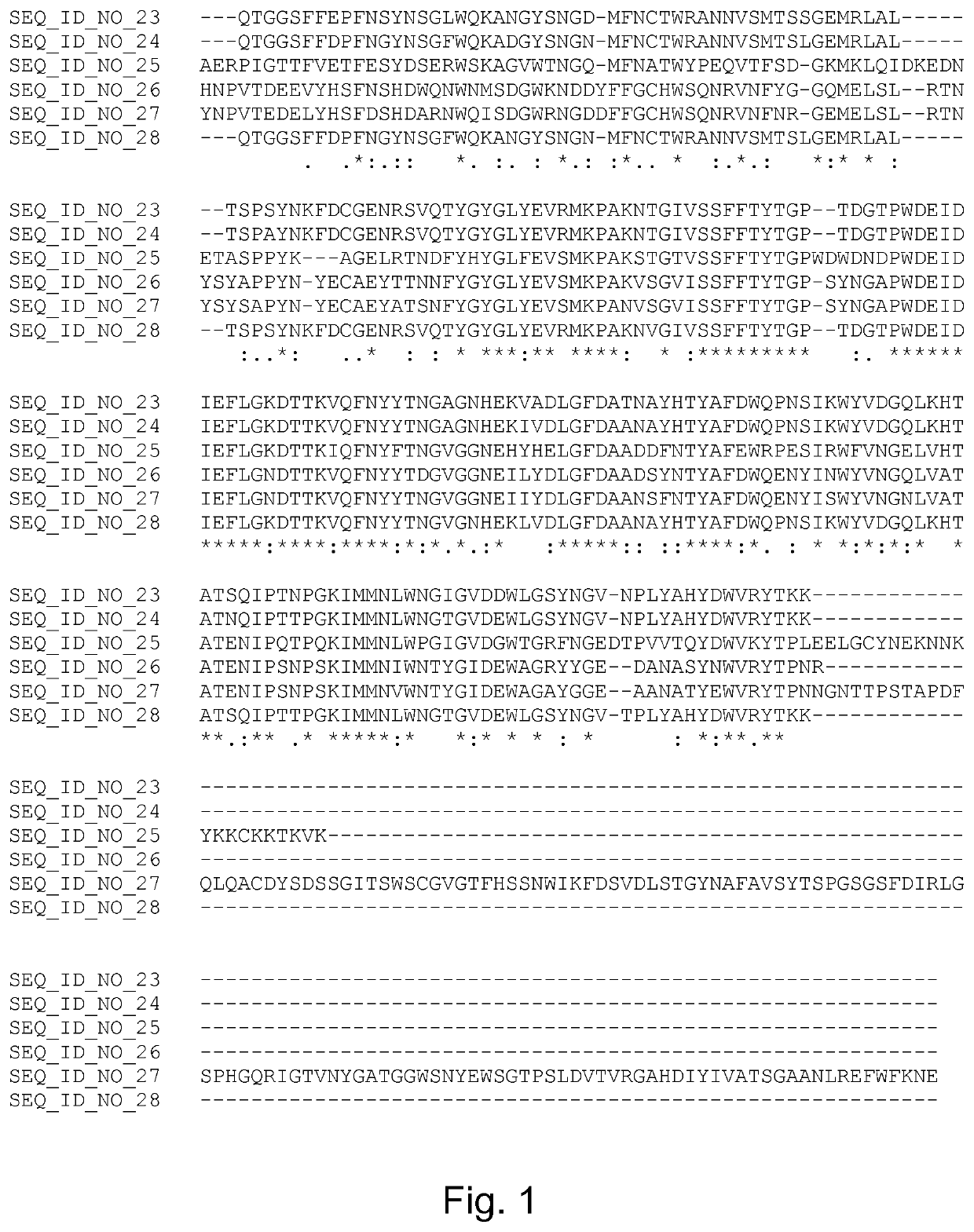Beta-glucanase variants and polynucleotides encoding same
a technology of beta-glucanase and polynucleotide, which is applied in the direction of detergent compositions, detergent compounding agents, enzymology, etc., can solve the problems of insoluble cellulose micro-fibril formation and generally not suitable for alkaline applications
- Summary
- Abstract
- Description
- Claims
- Application Information
AI Technical Summary
Benefits of technology
Problems solved by technology
Method used
Image
Examples
example 1
Determination of Beta-Glucanase Activity
[0552]An AZCL-Barley beta-glucan (azurine dye covalently cross-linked beta-glucan) assay was used for detection of endo-glucancase activity. AZCL-Barley beta-glucan (75 mg) was suspended in 15 mL detergent (Model detergents A, X, Z with and without bleach and pH adjusted, ADW Model A). To 1 mL of this solution in Eppendorf tubes was added 10 μL enzyme (0.33 mg enzyme protein / Liter), incubated for 15 min at 40° C. while shaking at 1250 rpm in a pre-heated thermo mixer and spun down for 2 min at 13200 rpm, diluted 5 times with a 5% Triton-X-100 including 10 μM CaCl2 and 250 μL of the solution was transferred to a micro-titer plate and the sample absorbance was measured at 590 nm.
example 2
Cloning, Expression and Purification of GH16 Endo-β-1,3-1,4-Glucanase from the Genus Bacillus
[0553]The beta-glucanases were derived from bacterial strains obtain either from the German collection of Microorganisms and Cell Cultures (DSMZ) or by isolation from environmental samples by classical microbiological techniques according to Table 1.
TABLE 1Source and Source country of GH16 endo- β-1,3-1,4-glucanase from the genus BacillusStrain nameSourceSource CountryBacillus sp-62449Environmental sampleUnited StatesBacillus akibaiSoilGreeceBacillus agaradhaerensSoilUnited StatesBacillus mojavensisDSMZ (DSM9205)United States
[0554]Chromosomal DNA from pure cultures of the individual strains was purified and subjected to full genome sequencing using Illumina technology. The assembled genome sequence and subsequent analysis of the 16S ribosomal subunit gene sequences confirmed the identity of the strains.
[0555]The individual genes encoding β-1,3-1,4-glucanases were amplified by PCR and fused ...
example 3
AZCL-Assay with Beta-Glucanase Enzymes
[0561]In this example enzymatic activity were measured on AZCL-Barely beta-glucan substrate under various pH's, temperature and detergent thus modeling various laundry conditions. Measurements of enzymatic activity were carried out as described in example 1, but without the 5 times dilution with 5% Triton-X-100 including 10 μM CaCl2. Comparisons were made with beta-glucanase from Bacillus amyloliquefaciens and beta-glucanase from Bacillus subtilis in Model detergent A, Model detergent X, Model detergent Z with bleach, Model detergent Z without bleach, Model detergent Z with bleach pH-adjusted and Model Z without bleach pH-adjusted detergent compositions.
TABLE 2Beta-glucanase activity measured under various pH's, temperatures andlaundry detergents using the AZCL-Barley beta-glucan assay (Absorbance):pH 11.1Model ZpH 11.3pH 10.5pH 10.6withModel ZModel ZModel ZbleachwithoutpH 7.7pH 10.1withwithoutpH-bleach pH-Model AModel Xbleachbleachadjustedadjus...
PUM
| Property | Measurement | Unit |
|---|---|---|
| pH | aaaaa | aaaaa |
| temperature | aaaaa | aaaaa |
| temperature | aaaaa | aaaaa |
Abstract
Description
Claims
Application Information
 Login to View More
Login to View More - R&D
- Intellectual Property
- Life Sciences
- Materials
- Tech Scout
- Unparalleled Data Quality
- Higher Quality Content
- 60% Fewer Hallucinations
Browse by: Latest US Patents, China's latest patents, Technical Efficacy Thesaurus, Application Domain, Technology Topic, Popular Technical Reports.
© 2025 PatSnap. All rights reserved.Legal|Privacy policy|Modern Slavery Act Transparency Statement|Sitemap|About US| Contact US: help@patsnap.com

